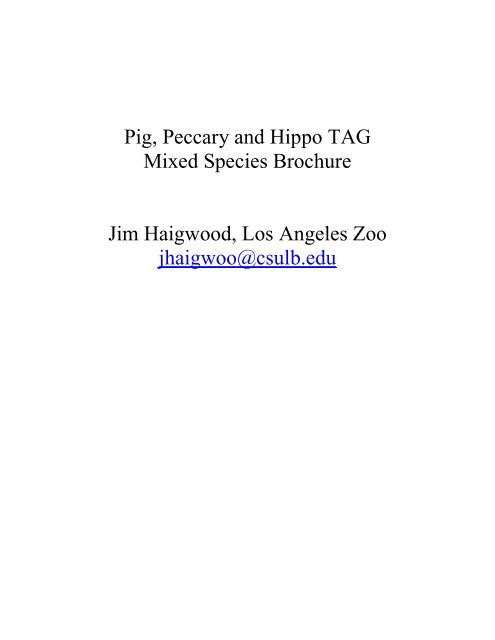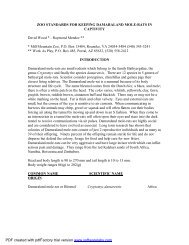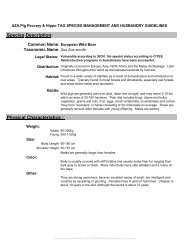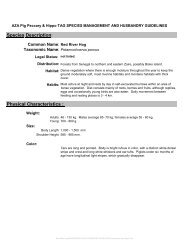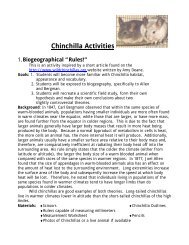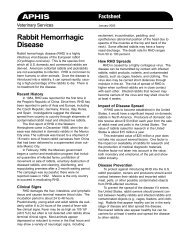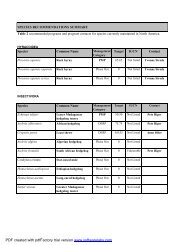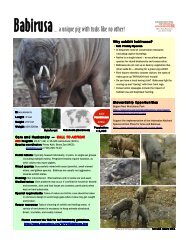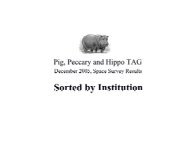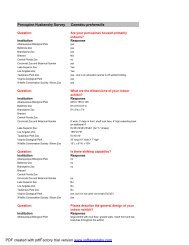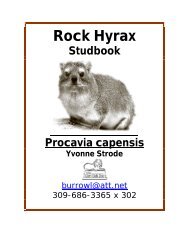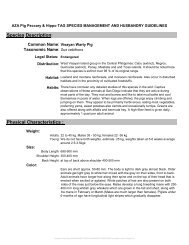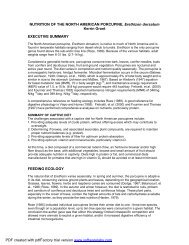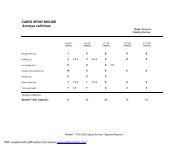PPH TAG Mixed Species
PPH TAG Mixed Species
PPH TAG Mixed Species
You also want an ePaper? Increase the reach of your titles
YUMPU automatically turns print PDFs into web optimized ePapers that Google loves.
Pig, Peccary and Hippo <strong>TAG</strong><br />
<strong>Mixed</strong> <strong>Species</strong> Brochure<br />
Jim Haigwood, Los Angeles Zoo<br />
jhaigwoo@csulb.edu
Things have never been more exciting for the Wild Pig, Peccary and Hippo <strong>TAG</strong>. There are<br />
currently 11 species of pigs and peccaries being displayed in North America, including the<br />
Endangered Chacoan peccary (Catagonus wagneri) and one of the most Critically Endangered<br />
pig species in the world, the Visayan warty pig (Sus cebifrons). These two exotic swine species<br />
are not only rare in the wild, but surprisingly enough are not often seen in zoos either. At<br />
present, only seven zoos are exhibiting the Chacoan peccary, and on an even more shocking<br />
note, there are only THREE zoos exhibiting the Visayan warty pig. The <strong>TAG</strong> is currently<br />
looking to get more institutions involved with exotic swine species, especially the Chacoan<br />
peccary and the Visayan warty pig.<br />
The purpose of this packet is four-fold:<br />
• To serve as a reminder that pigs and peccaries are magnificent, charismatic and intelligent<br />
animals that your patrons will love and remember<br />
• To inform you that the <strong>TAG</strong> is interested in finding institutions to house the Endangered<br />
Chacoan peccary and the Critically Endangered Visayan warty pig<br />
• To show what mixed species exhibits that include pigs and peccaries currently exist, have<br />
existed, and possibly to inspire still others to be attempted<br />
• Finally, there is a questionnaire attached that will help the <strong>TAG</strong> understand why your<br />
institution has not shown more interest in working with wild pigs and peccaries, especially<br />
the Endangered Chacoan peccary and the Critically Endangered Visayan warty pig. The<br />
<strong>TAG</strong> would be most appreciative if you would fill this out and return it to us by September<br />
30 th .<br />
“I NEED A HOME!!!”<br />
Tad Motoyama / Los Angeles Zoo<br />
Wild pig, peccary and hippo <strong>Mixed</strong> <strong>Species</strong> Info Page #1
QuickTime and a<br />
TIFF (LZW) decompressor<br />
are needed to see this picture.<br />
The unique appearance, intelligence, and industrious nature of exotic pigs and peccaries are just<br />
some of the appealing qualities that make these animals so charismatic. These same qualities<br />
also make exotic pigs and peccaries lively and entertaining species that will be enjoyed by your<br />
public. Your institution should utilize this popularity in the same manner that it has been used by<br />
the entertainment industry, which has had a longstanding tradition of using pigs as the focus of<br />
many popular films and books.<br />
Pigs and peccaries are currently being incorporated into many<br />
interesting and exciting mixed species exhibits. While various<br />
hoofstock species would appear to be the most obvious choices<br />
with which to display them, some of these exhibits have included<br />
birds, monkeys and even apes. In the following pages, you will see<br />
photographs of some of these exhibits and descriptions of other<br />
mixes as well<br />
Tad Motoyama / Los Angeles Zoo<br />
Currently, there are two highly Endangered species that the <strong>TAG</strong> would like more institutions to<br />
take an interest in. Both the Chacoan peccary and the Visayan warty pig not only have unique<br />
physical characteristics that make them fascinating to display, but each also has its own<br />
conservation story that is worthy of note. In addition, the IUCN/SSC Pigs and Peccaries<br />
Specialist Group has recommended the captive breeding of these two<br />
species to occur in order to act as a genetic reservoir. If more<br />
institutions become involved, then the SSPs for these two species can<br />
recommend breeding; if successful, the presence of piglets for the<br />
public to see will not only draw more attention to your institution, but<br />
will also create a greater interest in these animals. The possibility also<br />
exists that these species could become part of a reintroduction program<br />
in the future, a conservation story that the public would enjoy hearing.<br />
Tad Motoyama / Los Angeles Zoo<br />
Tad Motoyama / Los Angeles Zoo<br />
With a friendly and sympathetic face to go along with a noteworthy<br />
history of discovery, the Chacoan peccary is both an attractive<br />
animal to display and a fascinating story to communicate to the<br />
public. Currently, the Chacoan peccary is the largest peccary<br />
species kept in captivity. With its large head and long legs, the<br />
Chacoan peccary is a much easier animal to spot in an exhibit than<br />
the smaller and more common collared peccary. Also, since the<br />
Chacoan peccary is naturally found in large mixed sex groups, your<br />
zoo can display a large group with both males and females in an<br />
exhibit that is sure to be lively and entertaining for your public.<br />
Since the Chacoan peccary was rediscovered only in the last thirty years, this animal serves as an<br />
important reminder that we must preserve wildlife habitat or else end up losing species to<br />
extinction prior them ever being discovered.<br />
Wild pig, peccary and hippo <strong>Mixed</strong> <strong>Species</strong> Info Page #2
The Visayan warty pig is exotic in appearance and is an<br />
extremely rare animal to be witnessed both in captivity<br />
and its native Philippines. Part of its exotic appearance<br />
can be attributed to the prominent crest and mane this<br />
animal develops during its breeding season. The<br />
Visayan warty pig is the only pig species to exhibit these<br />
eye-catching traits, and its “rock star” appearance is sure<br />
to grab your public’s attention. This species also<br />
presents the possibility to educate the public about many<br />
conservation issues including what a hotspot is and the<br />
possible extinction of a species through hybridization<br />
with feral stock.<br />
Tad Motoyama / Los Angeles Zoo<br />
Tad Motoyama / Los Angeles Zoo<br />
Unfortunately, what appears to be keeping these two Endangered species from being exhibited is<br />
a general disinterest in working with wild swine and possibly a lack of space. While these two<br />
species desperately need to increase their numbers, currently about 70% of the space dedicated to<br />
exotic swine species in AZA zoos is being allocated to three species that are considered common<br />
or abundant by the IUCN: collared peccaries, red river hogs and common warthogs. Although<br />
the <strong>TAG</strong> recognizes the importance of displaying these animals, perhaps some institutions can<br />
reassess their commitments from the more common species in favor of the two more Endangered<br />
ones. For example, while part of the collared peccaries’ range is in the American Southwest,<br />
70% of the zoos that exhibit this species are located outside of this region. Possibly, some of<br />
these institutions can reassess their commitment to keeping javelinas over Chacoan peccaries.<br />
For institutions housing species of wild swine that are currently not in danger, perhaps under the<br />
right situations these animals could be placed in mixed species exhibits (e.g. red river hogs with<br />
bongo) to free up space for either the Visayan warty pig or the Chacoan peccary. If your<br />
institution does not currently work with any exotic swine or only the more common species, the<br />
<strong>TAG</strong> would appreciate it if you would fill out the questionnaire and think about displaying<br />
species like the Chacoan peccary and the Visayan warty pig in your zoo.<br />
Wild pig, peccary and hippo <strong>Mixed</strong> <strong>Species</strong> Info Page #3
<strong>Mixed</strong> <strong>Species</strong> Exhibits<br />
The following is a list of mixed species exhibits that are either currently being displayed or have<br />
been in the past. When determining whether a mix will be successful, it is important to keep in<br />
mind that the temperaments of the individuals involved in a mixed species exhibit are as<br />
important as the temperaments of the species themselves. As you will see, exotic pigs and<br />
peccaries are being included in many exciting mixed species exhibits that are entertaining,<br />
educating and captivating the public’s attention.<br />
Jane Anne Franklin/ Louisville Zoo Liesl King / Disney's Animal Kingdom Lodge Liesl King / Disney's Animal Kingdom Lodge<br />
QuickTime and a<br />
TIFF (LZW) decompressor<br />
are needed to see this picture.<br />
QuickTime and a<br />
TIFF (LZW) decompressor<br />
are needed to see this picture.<br />
Julie Larsen Maher / Wildlife Conservation Society<br />
Julie Larsen Maher / Wildlife Conservation Society<br />
Wild Boar (Sus scrofa)<br />
Josh Zelt / San Diego Zoological Society<br />
Wild Boar Other <strong>Species</strong> in <strong>Mixed</strong> Exhibit Institution<br />
0.3 Wild Boar 1.3 Javan Banteng Bos San Diego Zoo<br />
javanicus javanicus)<br />
Wild pig, peccary and hippo <strong>Mixed</strong> <strong>Species</strong> Info Page #4
QuickTime and a<br />
TIFF (LZW) decompressor<br />
are needed to see this picture.<br />
Red River Hog (Potamochoerus porcus)<br />
QuickTime and a<br />
TIFF (LZW) decompressor<br />
are needed to see this picture.<br />
Julie Larsen Maher / Wildlife Conservation Society<br />
Liesl King / Disney's Animal Kingdom Lodge<br />
QuickTime and a<br />
TIFF (LZW) decompressor<br />
are needed to see this picture.<br />
Tad Motoyama / Los Angeles Zoo<br />
Julie Larsen Maher / Wildlife Conservation Society<br />
Red River Hogs Other <strong>Species</strong> in <strong>Mixed</strong> Exhibit Institution<br />
1.1 Red River Hogs 0.1 Bongo (Tragelaphus eurycerus) Los Angeles Zoo<br />
3.3 Red River Hogs 0.2 De Brazza Guenons (Cercopithecus The Bronx Zoo<br />
neglectus)<br />
1.1 Mandrills (Mandrillus sphinx)<br />
1.1 Red River Hogs 8.8 Bonobos (Pan paniscus) * Columbus Zoo<br />
1.1 Red River Hogs 2.0 Bat-Eared Foxes (Otocyon megalotis) St Louis Zoo<br />
3.4 Red River Hogs 1.3.2 Ankole Cattle (Bos taurus) Duisburg Zoo<br />
0.1 Red River Hog 0.1 Giant Forest Hog (Hylochoerus<br />
San Diego Zoo<br />
meinertzhageni ivoriensis)<br />
1.2 Red River Hogs 3.0 Giraffe (Giraffa camelopardalis)<br />
1.3 Waterbuck (Kobus ellipsiprymnus)<br />
Disney’s Animal<br />
Kingdom Lodge<br />
1.2 Grant's gazelle (Gazella granti)<br />
1.2 Ankole cattle (Bos taurus)<br />
1.4 Nyala (Tragelaphus angasi)<br />
0.5 Ostrich (Struthio camelus)<br />
0.2 Abyssinian ground hornbills (Bucorvus<br />
abyssinicus)<br />
3.0 Crowned cranes (Balearica pavonina)<br />
1.2 Marabou stork (Leptoptilos crumeniferus)<br />
2.3 Ruppel’s vultures (Gyps rueppelli)<br />
*Animals not always exhibited together<br />
Wild pig, peccary and hippo <strong>Mixed</strong> <strong>Species</strong> Info Page #5
Babirusa (Babyrousa babyrussa)<br />
Tad Motoyama / Los Angeles Zoo<br />
Joe Forys / Audubon Zoo<br />
Babirusa Other <strong>Species</strong> in <strong>Mixed</strong> Exhibit Institution<br />
2.1 Babirusa 0.2 Asian Small Clawed Otters (Amblonyx<br />
Audubon Zoo<br />
cinereus)<br />
0.1 Babirusa 0.1 Lowland Anoa (Bubalus depressicornis) Los Angeles Zoo<br />
1.0, 0.3 and 1.1<br />
Louisville Zoo<br />
Babirusa 1.1 Siamang (Hylobates syndactylus) *<br />
*Animals not always exhibited together<br />
Common Warthog (Phacocoerus africanus)<br />
Allison Ringler / San Diego Zoological Society<br />
Jiim Haigwood Los Angeles Zoo / Photo: San Diego Zoo<br />
Common Warthog Other <strong>Species</strong> in <strong>Mixed</strong> Exhibit Institution<br />
0.2 Common Warthog 1.2 Bat-Eared Foxes (Otocyon megalotis) San Diego Wild<br />
Animal Park<br />
1.0 Common Warthog 1.1.1 Cuvier’s Gazelle (Gazella cuvieri) St Louis Zoo<br />
1.0 Common Warthog 1.0 Damara Zebra (Equus burchelli<br />
San Diego Zoo<br />
antiquorium)<br />
4.0 Cuvier’s Gazelle (Gazella cuvier)i<br />
4.0 Soemmering’s Gazelle (Gazella s<br />
soemmerringii)<br />
3.0 Common Warthogs 1.6 Zambian Sable (Hippotragus niger kirkii) San Diego Zoo<br />
1.4 Common Warthogs 1.4 Chapman’s Zebras (Equus burchelli<br />
chapmani)<br />
1.3 Ostriches (Struthio camelus)<br />
Hagenbeck Zoo<br />
Wild pig, peccary and hippo <strong>Mixed</strong> <strong>Species</strong> Info Page #1
Collared Peccary (Pecari tajacu)<br />
Roberto Aguilar, D.V.M. / Audubon Zoo<br />
Collared Peccary Other <strong>Species</strong> in <strong>Mixed</strong> Exhibit Institution<br />
1.0 Collared Peccary 1.2 Tule Elk (Cervus elaphus nannodes) Audubon Zoo<br />
1.0 Collared Peccary 1.2 Tule Elk (Cervus elaphus nannodes) Audubon Zoo<br />
2.2 American Wild Turkey (Meleagris<br />
gallopavo)<br />
0.3 White-Tailed Deer (Odocoileus<br />
virginianus)<br />
1.0 Collared Peccary 0.4 Guanaco (Lama guanicoe)<br />
1.2 Brazillian Tapir (Tapirus terrestris)<br />
2.3 Capybara (Hydrochoerus hydrochaeris)<br />
1.0 Red-Legged seriema (Cariama cristata)<br />
1.1 Crested Screamer (Chauna torquata)<br />
1.2 Rhea (Pterocnemia pennata)<br />
1.1 Orinoco Geese (Neochen jubata)<br />
1.1 Ruddy Headed Geese (Chloephaga<br />
rubidiceps)<br />
3.2 Bahama (White-Cheeked) Pintail (Anas<br />
bahamensis)<br />
10.6 Black-Bellied Whistling Ducks<br />
(Dendrocygna autumnalis)<br />
3.2 Chiloe Widgeon (Anas sibilatrix)<br />
2.2 Rosy-Bill Pochard (Netta peposaca)<br />
3.1 Sharp-Winged Teal (Anas Oxypterum)<br />
5.5 White-faced Whistling duck<br />
(Dendrocygna viduata)<br />
1.1 Black-necked swan (Cygnus<br />
melanocoryph)<br />
Audubon Zoo<br />
Wild pig, peccary and hippo <strong>Mixed</strong> <strong>Species</strong> Info Page #7


